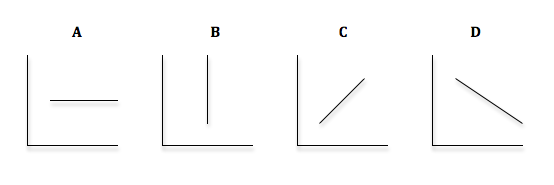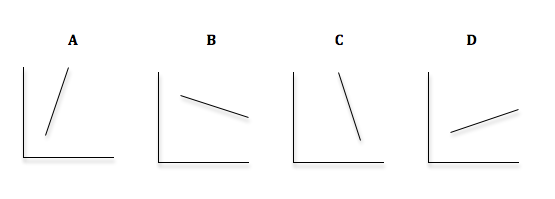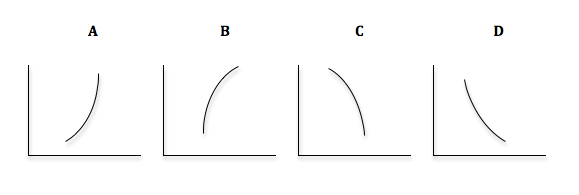ASSIGNMENT
#1
LINEAR & NON-LINEAR GRAPHS

ASSIGNMENT
#1
LINEAR & NON-LINEAR GRAPHS

1. Which of the above has a slope approximately equal to 1?
a. A
b. B
c. C
d. A and B
e. None
2. Which of the above has a slope approximately equal to 0?
a. A
b. B
c. C
d. A and B
e. None
3. Which of the above has a slope approximately equal to -1?
a. A
b. B
c. C
d. D
e. None
4. In which graph above would the Quantity rise if the Price falls?
a. A
b. B
c. C
d. D
e. None
5. In which graph above would the Quantity rise if the Price rises?
a. A
b. B
c. C
d. A and B
e. None

6. Which of the lines above has a slope between 0 and -1?
a. A
b. B
c. C
d. A and B
e. None
7. Which of the lines above has a slope between 1 and - infinity ?
a. A
b. B
c. C
d. A and B
e. None
8. In which of the graphs immediately above would a large increase in Price cause a small decrease in Quantity?
a. A
b. B
c. C
d. D
e. None
9. In which of the graphs immediately above would a small increase in Price cause a large decrease in Quantity?
a. A
b. B
c. C
d. D
e. None
10. In which of the graphs immediately above would a small increase in Price cause a large increase in Quantity?
a. A
b. B
c. C
d. D
e. None

11. Which of the graphs immediately above is/are concave?
a. A
b. B
c. A and B
d. A and C
e. B and D
12. Which of the graphs immediately above is/are convex?
a. A
b. B
c. A and C
d. B and C
e. B and De
13. Which of the graphs immediately above has a positive slope at every point?
a. A
b. B
c. C
d. D
e. None
14. Which of the graphs immediately above has a slope which starts off being a large positive number, changes to a smaller positive number, then becomes equal to 0, then becomes increasingly negative?
a. A
b. B
A and B
d. C
e. D
15. Which of the graphs immediately above is negative-sloped at every point and gets more negative at an increasing rate, from left to right?
a. A
b. B
c. C
d. D
e. None

16. In which of the graphs immediately above would a small increase in Price cause a large decrease in Quantity?
a. A
b. B
c. C
d. D
e. None
17. In which of the graphs immediately above would a large increase in Price cause a small decrease in Quantity?
a. A
b. B
c. C
d. A and D
e. B and C
18. In which of the graphs immediately above would a large increase in Price cause a small increase in Quantity?
a. A
b. B
c. C
d. A and D
e. B and C
19. In which of the graphs immediately above would a large decrease in Price cause a small increase in Quantity?
a. A
b. B
c. C
d. A and D
e. B and C
20. In which of the graphs immediately above does a positive slope get larger at an increasing rate, from left to right?
a. A
b. B
c. C
d. D
e. None

21. In which of the graphs immediately above would a small increase in Price cause a large decrease in Quantity?
a. A
b. B
c. A and B
d. C and D
e. None
22. In which of the graphs immediately above would a small increase in Price cause a large increase in Quantity?
a. A
b. B
c. A and B
d. C and D
e. None
23. In which of the graphs immediately above would a large increase in Price cause a large decrease in Quantity?
a. A
b. B
c. C
d. D
e. None
24. In which of the graphs immediately above does the slope get larger from left to right, but stays positive?
a. A
b. B
c. C
d. D
e. None
25. In which of the graphs immediately above does the slope get more negative at an decreasing rate?
a. A
b. B
c. C
d. D
e. None